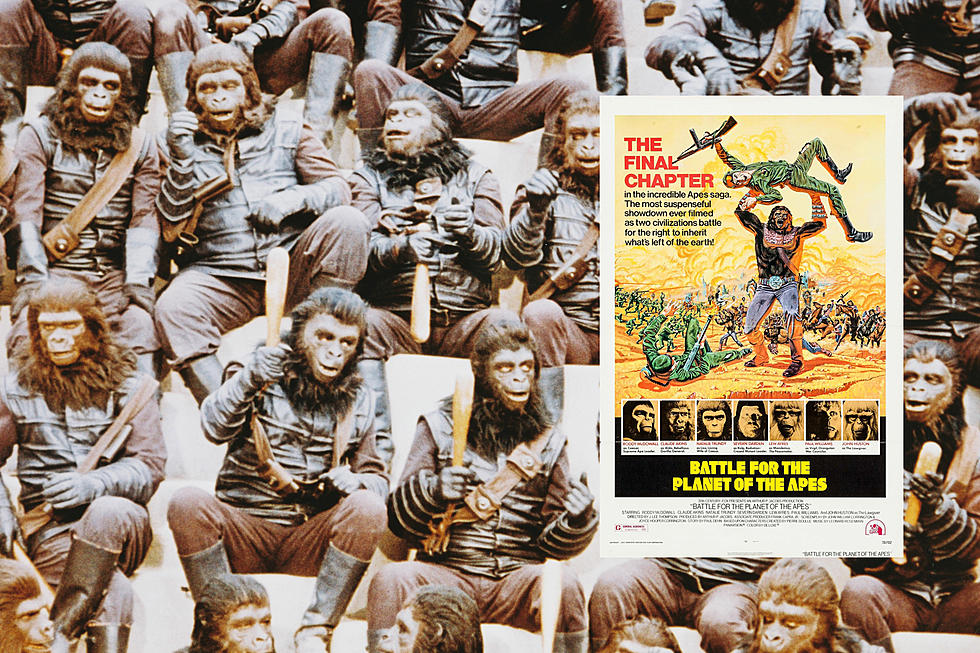
50 Years Ago: Original ‘Planet of the Apes’ Franchise Ends With a Whimper
The original Planet of the Apes was a massive financial success and a groundbreaking achievement in the science fiction genre. So it was especially disappointing when, five years later, the original franchise ended with a whimper with Battle for the Planet of the Apes.
Released on June 13, 1973, the fifth and final installment in the original Apes saga continues the plot of the previous two films, 1971's Escape From the Planet of the Apes and 1972's Conquest of the Planet of the Apes. Escape tells the story of several chimpanzees who escape from the future (where the first two films took place) and return to present-day Earth. Humans first regard the chimps Cornelius and Zira as a curiosity because of their intelligence, but they eventually come to see them as threats and kill them at the end of the film.
Their child, Caesar, survives, and Conquest of the Planet of the Apes chronicles the successful revolution he leads against a society in which humans have enslaved apes. Escape and Conquest both did well at the box office, and they leaned into a naked allegory about race relations in the late '60s and early '70s.
Despite the success of these movies, by the time Battle for the Planet of the Apes arrived, the franchise had begun to feel doomed. The reasons were largely financial. Although the original Planet of the Apes became a cultural phenomenon, executives at 20th Century Fox slashed the budget of each successive film, rather than capitalizing on the interest of its fan base to make bigger and more ambitious movies.
Consequently, Escape and Conquest were both set in the present day to avoid expensive, futuristic set designs. For Battle, the studio set the budget at $1.8 million — an insultingly small amount for a sci-fi epic, especially considering the success of previous entries, and a far cry from the original film's $5.8 million.
These restrictions show in nearly every frame of the film. The plot is centered on Caesar (Roddy McDowall, who played Caesar's father Cornelius in the first and third films, before switching to the role of Caesar for the fourth film), who is now the head of the prosperous and relatively peaceful Ape City. The apes are in charge and the humans are mostly free, although they do most of the manual labor. But beneath this stability, there are signs of unrest. A group of more aggressive gorillas led by Aldo (Claude Akins) wants to imprison all humans in the name of ape supremacy.
Watch the 'Battle for the Planet of the Apes' Trailer
Another plot twist comes when Caesar decides that he wants to journey to the Forbidden City – a human city that was destroyed by a nuclear explosion in the previous film – to find old video archives that contain footage of his parents. This journey brings Caesar and Ape City to the attention of the mutated humans that live in the Forbidden City. Under the leadership of the nefarious Kolp (Severn Darden), they decide to kill the apes once and for all.
This leads to a pair of final confrontations: one in which Caesar leads the apes to defeat the mutated humans from the Forbidden City, and a second in which he triumphs over Aldo. The film ends with Caesar deciding to create a society in which humans and apes are equal.
The plot is thin, and the scant resources render a good deal of it ridiculous. Ape City is mostly a collection of hastily constructed treehouses (the film was shot on the Fox Movie Ranch, outside of Malibu), the titular battle scenes are flimsy and the Forbidden City looks like it was shot on a small, cheaply designed sound stage. Not even the estimable talents of director J. Lee Thompson (who made Cape Fear and was nominated for a Best Director Oscar for The Guns of the Navarone) are enough to salvage the proceedings.
It was a pitiful, unceremonious end to a franchise that had already proven its critical and commercial viability with its first film, which marked an enormous step forward in prosthetic makeup design, became a classic of the genre and made a great deal of money for 20th Century Fox. A lucrative 2001 remake of the original movie and a successful reboot trilogy in the '10s once again proved there was still plenty of interest in Planet of the Apes.
But those later successes arrived at a time when the franchise model of Hollywood filmmaking was well established, and the industry had figured out how to lure moviegoers to the theater with new iterations of the same story. Studios hadn't yet mastered that art when Battle for the Planet of the Apes landed with a thud, and as a result, they destroyed what could have been an even more enduring and fascinating series.



